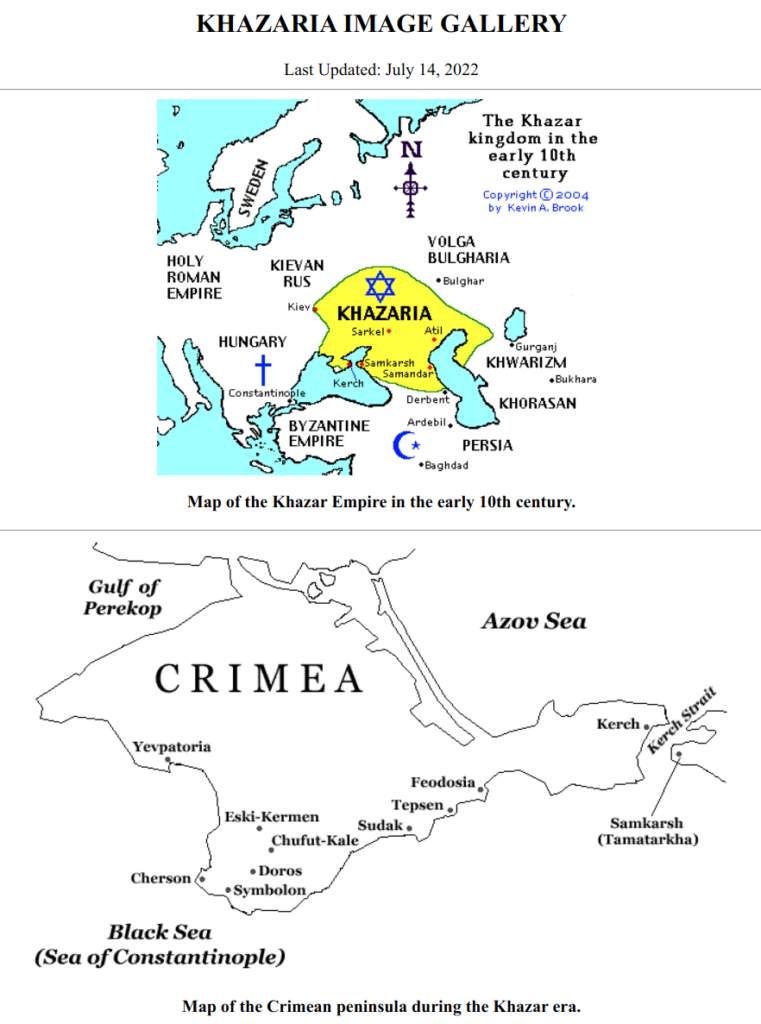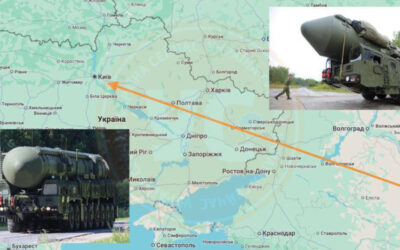Khazains, What Would They Do?
The property lease for all of Israel ran out on Oct. 31 2023 called the Balford Accord. So I will bet the whole Ukraine thing was a Plan B if forced to leave Israel, they would have somewhere to go. The sick part is now we know why they(Khazars) turned the Ukraine into a slaughter house using Russia to do the Dirty Work. New land owners coming and they don’t pay for anything.

Source: http://www.khazaria.com/brook.html
The Jews of Khazaria recounts the eventful history of the Turkic kingdom of Khazaria, which was located in eastern Europe and flourished as an independent state from about 650 to 969. As a major world power, Khazaria enjoyed diplomatic and trade relations with many peoples and nations (including the Byzantines, Alans, Magyars, and Slavs) and changed the course of medieval history in many ways. Did you know that if not for the Khazars, much of eastern Europe would have been conquered by the Arabs and become Islamic? In the same way as Charles Martel and his Franks stopped the advance of Muslims at the Battle of Poitiers in the West, the Khazars blunted the northward advance of the Arabs that was surging across the Caucasus in the 8th century.
The Khazar people belonged to a grouping of Turks who wrote in a runic script that originated in Mongolia. The royalty of the Khazar kingdom was descended from the Ashina Turkic dynasty. In the 9th century, the Khazarian royalty and nobility as well as a significant portion of the Khazarian Turkic population embraced the Jewish religion. After their conversion, the Khazars were ruled by a succession of Jewish kings and began to adopt the hallmarks of Jewish civilization, including the Torah and Talmud, the Hebrew script, and the observance of Jewish holidays. Portions of the empire’s population adopted Christianity and Islam.
This volume traces the development of the Khazars from their early beginnings as a tribe to the decline and fall of their kingdom. It demonstrates that Khazaria had manufacturing industries, trade routes, an organized judicial system, and a diverse population. It also examines the many migrations of the Khazar people into Hungary, Ukraine, and other areas of Europe and their subsequent assimilation, providing the most comprehensive treatment of this complex issue to date. The final chapter enumerates the Jewish communities of eastern Europe that sprang up after the fall of Khazaria and shows that modern Jews from the former Russian Empire are descended from a mixture of German Jews, Czech Jews, Sephardic Jews, and Slavs but do not descend from Khazar Jews.
The Jews of Khazaria draws upon the latest archival, linguistic, genetic, and archaeological discoveries. The weaponry, agriculture, horticulture, fishing, burial practices, architecture, and religions of the peoples of Khazaria are among the many findings revealed here.
The book also includes a map of the Khazar kingdom; a map of Khazarian-ruled Crimea; tables illustrating royal genealogies, the Turkic language family, and Turkic Khazarian personal names; a glossary of Khazarian words and other important terms which may be unfamiliar to readers; and an extensive bibliography listing hundreds of books and articles.
-
Students and other people interested in history who desire a thorough yet easy-to-read account of the Khazar kingdom will gain in their understanding of this important but previously obscure topic.
-
Ashkenazic Jews who wish to explore their distant ancestry in eastern Europe will greatly benefit from reading this book, particularly Chapter 10, which traces Jewish migrations across Europe in medieval times.
-
Hungarians, Ukrainians, Chuvashes, Volga Tatars, Turks, Arabs, and Ossetians will find a wealth of information concerning the historical interactions between their ancestral peoples and the Khazars.
TABLE OF CONTENTS for the 3rd Edition Acknowledgments
IntroductionChapter 1 — THE ORIGINS OF THE KHAZARS:
The Turkic Heritage, Legends about the Beginnings of the Jewish Khazars, The Khazars and the Huns, The Western Turkish Empire, The Formation of an Independent Khazar Kingdom, The Effects of Khazar Expansion on the Bulgars, The Genetics of Khazaria’s Core PopulationsChapter 2 — THE CITIES AND TOWNS OF THE KHAZARS:
The Capital Cities of Khazaria, Atil and Khazaran, Balanjar, Chernigov, Cherson, Chufut-Kale, Doros, Feodosia, Kerch (Bospor), Khumar, Kiev, Kordon-Oba, Mayaki, Samandar (Tamatarkha), Sarkel, Semikarakorskaya, Sudak, Tepsen (Phullai), Upper Saltov (Verkhnii Saltov), Other Khazar Settlements and Fortresses, The Peoples of the Khazar EmpireChapter 3 — THE STRUCTURE OF THE KHAZAR GOVERNMENT:
The Kagan, The Bek (King) and His Army, The Kender and the Javshighar, The Tarkhan, The Court Panel, The Local Governors, Taxation, Tributary PeoplesChapter 4 — THE KHAZAR WAY OF LIFE:
Khazar Arts and Crafts, Khazar Agriculture and Food Gathering, The Structure of Khazar Homes, Khazar Costume and Hairstyle, Khazar Graves, Languages Spoken by the KhazarsChapter 5 — KHAZARIAN TRADE:
Khazaria as a Great Medieval Trading Center, The Jewish Radhanites, Rus’ Traders in Khazaria, Arab Traders in Khazaria, Chinese Traders in Khazaria, CoinageChapter 6 — THE KHAZARS’ CONVERSION TO JUDAISM:
The First Jews of Eastern Europe, Khazaria as a Refuge for Persecuted Jews, Tengri Shamanism, the Indigenous Religion of the Khazars, King Bulan’s Conversion to Judaism, The Schechter Letter, The Khazar Correspondence, Saint Cyril’s Mission to the Khazars, The Kievan Letter, The Date and Depth of the Khazar Conversion to Judaism, Archaeological Evidence, ConclusionsChapter 7 — RELATIONS BETWEEN THE KHAZARS AND OTHER PEOPLES:
The Arab-Khazar Wars and Relations with Leaders of the South Caucasus, Relations with the Byzantine Empire, Relations with the Alans, Relations with Other Turkic Tribes, Relations with the Hungarians, Relations with the Rus’Chapter 8 — THE DECLINE AND FALL OF THE KHAZAR EMPIRE:
The Beginning of the End, The Rus’ian Conquest of the Khazar Empire, The Passing of the Khazar Empire, Reasons for Khazaria’s DestructionChapter 9 — THE DIASPORA OF THE KHAZARS:
Khazars in Hungary, Khazars in Transylvania (Romania), Khazars in Lithuania and Belarus[?], Khazars in Poland[?], Khazars in Kievan Rus’ (Ukraine), Khazars in the Byzantine Empire, Khazars in Spain, Khazars in Azerbaijan, Khazars in the North Caucasus, Khazars in Russia, Khazars in Kazakhstan, Khazars in Other Parts of the WorldChapter 10 — EASTERN AND CENTRAL EUROPEAN JEWS AFTER THE TENTH CENTURY:
The East Slavic-Speaking Jews of Eastern Europe, The Migration of Czech Jews into Eastern Europe, The Migration of German Jews into Eastern Europe, How Yiddish Became the Mother Tongue of Eastern European Jews, Are There Khazarian Words in Yiddish?, The Migration of Sephardic Jews into Eastern Europe, The Migration of Romaniote (“Greek”) Jews into Eastern Europe, The Migration of Mizrakhi (“Eastern”) Jews into Eastern Europe, Jews in Medieval Ukraine, Other Early Traces of Jews in Poland, Jews in Lithuania and Belarus, Jews in Hungary: A Special Case?, Jews in Historic Romania, What Genetic Data Demonstrates about Ashkenazic Origins, Do Ashkenazic Jews Descend from Khazars?, Do Krymchaks Descend from Khazars?, Do Crimean and Lithuanian Karaites Descend from Khazars?, Do Mountain Jews of the Caucasus Descend from Khazars?, ConclusionsAppendix A: Timeline of Khazar History
Appendix B: Glossary
Appendix C: Native Khazarian Personal Names
Appendix D: Other Instances of Conversion to Judaism in History
Bibliography
Index
About the Author




0 Comments